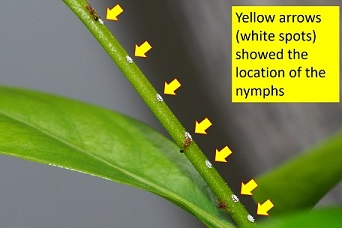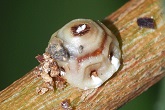| Home | Nature Weekly Index |
17 May 2020 | Wax Scale Insect Nymphs | Ceroplastes rusci |
 During a recent inspection of my potted plants in late April, I found a few tiny white spots along a small twig
of a young Syzygium polyanthum (Indonesian Bay Leaf)
with ants (Pheidole parva) patrolling around
them. With ants gathering around them, I was quite certain that the white spots were likely to be a kind of
honeydew-secreting insect. While the size of the ant was around 1 millimetre long, the size of the white spot
was even smaller. It was way too small to actually observe its feature. After enlarging the photos taken, it
became clear that they were a type of wax scale insect nymphs and a rather unusual one.
During a recent inspection of my potted plants in late April, I found a few tiny white spots along a small twig
of a young Syzygium polyanthum (Indonesian Bay Leaf)
with ants (Pheidole parva) patrolling around
them. With ants gathering around them, I was quite certain that the white spots were likely to be a kind of
honeydew-secreting insect. While the size of the ant was around 1 millimetre long, the size of the white spot
was even smaller. It was way too small to actually observe its feature. After enlarging the photos taken, it
became clear that they were a type of wax scale insect nymphs and a rather unusual one.
Scale insects are from the superfamily Coccoidea. Adult females typically have no limbs and hence, immobile (except the mealybugs) and permanently attached to the plant on which they are feeding. Scale insects often have a mutualistic relationship with ants, which feed on the honeydew and protect them from predators. Most scale insects are considered agricultural pests. Like any plant sap feeding insects, they insert their stylets or elongated mouthparts into the plant to feed, thereby weaken or kill the plant. The worst threat was their ability to transmit plant diseases that might result in serious crop damage. Their closest relatives are the jumping plant lice (Psylloidea), whiteflies (Aleyrodoidea) and aphids (Aphidoidea).


 Based on my online research, the wax scale insect on my plant should be a Ceroplastes species. The nymphs
secrete a wax covering around them, giving them a star-like appearance. The adult wax scale insect looked like a
mini flying saucer. Last weekend, I finally found the mothership hidden at the lower region of the stem.
Based on my online research, the wax scale insect on my plant should be a Ceroplastes species. The nymphs
secrete a wax covering around them, giving them a star-like appearance. The adult wax scale insect looked like a
mini flying saucer. Last weekend, I finally found the mothership hidden at the lower region of the stem.
I started to search for information on Ceroplastes species found in Singapore. The first candidate was Indian Wax Scale (Ceroplastes ceriferus) [1] described by the USDA website as being dark reddish brown in colour. However, in the Bugwoodwiki website, the live adults was described as bright white with the dead ones turning dull and grey. This species was mentioned as a new pest here in the Annual Report 2016/17 (page 69) from the Agri-Food and Veterinary Authority of Singapore. The second candidate was Red Wax Scale (Ceroplastes rubens) reported back in 1990 on some mangrove trees in Singapore [2].
Both of them did not match well with the colour of the adult wax scale insects found on my plant. Eventually, I landed on a more likely candidate, Fig Wax Scale (Ceroplastes rusci) [3] although I was not able to find any report on its sighting locally. This was the closest that I could get to its identity at the moment.
References:
[1] Ülgentürk S. A new introduced wax scale to Turkey: Ceroplastes ceriferus (Fabricius) (Hemiptera: Coccidae). Munis Entomol Zoology 2016;11(2):359-362. | Read article |
[2] Murphy DH. The natural history of insect herbivory on mangrove trees in and near Singapore. Raffles Bull Zoology 1990;38(2):119-203. | Read article |
[3] Pellizzari G, Rainato A, Stathas GJ. Description of the immature female instars of Ceroplastes rusci (Linnaeus) (Hemiptera: Coccidae). Zootaxa 2010;2556:40-50. | Read article |